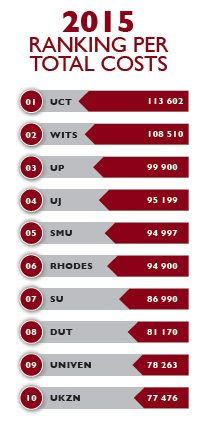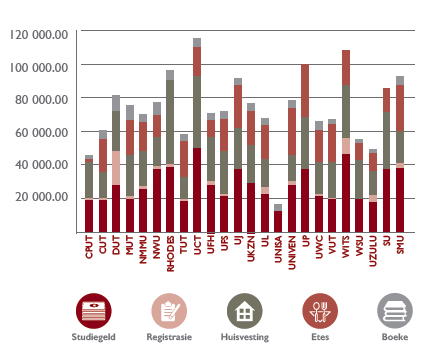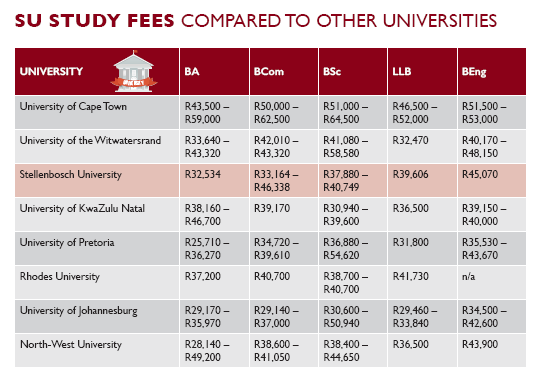2. Making sense of funding in the SA higher education sector
- ?Universities in South Africa have been chronically underfunded (annual increases below Consumer Price Index (CPI) for close on two decades which essentially is the current source of the financial crisis in higher education.
- South Africa’s investment in education as a % of the Gross Domestic Product (GDP) is much lower than in other countries.

- There has been a steady decline in the state subsidy, with an annual increase less than the CPI, while expenses increase by at least the Higher Education Price Index (HEPI).

Consumer Price Index (CPI)
Simply put, the Consumer Price Index (CPI) is a measure used to estimate price changes in a fixed basket of consumer goods and services. The consumer basket includes the cost of, for example, transport, food and medical care, and the CPI is an indication of the cost of living.Higher Education Price Index (HEPI)
Similarly, the Higher Education Price Index (HEPI) is a measure to estimate price changes in a fixed basket of goods and services acquired by the higher education sector. It includes professional salaries (universities place a high premium on the expertise of academic staff such as rated scientists), wages and fringe benefits, contracted services, library acquisitions, utilities, transportation, supplies and materials, and technology. The HEPI assists universities to determine the budget and funding increases required to ensure sustainable financial management of the institution. The HEPI is a more accurate indicator of the inflation rate applicable to universities than the CPI due to the higher costs of the HEPI fixed basket of goods and services.
Nominal annual increases in the block grant from the Department of Higher Education and Training for the Higher Education sector have been consistently less than the Consumer Price Index.

- The lack of sufficient funding was exacerbated by the 0% student fee increase announced for 2016, and it will have an expected ripple effect beyond 2019.
- Universities now require a minimum of an 8% increase in annual income for 2017 if they are to maintain current levels of academic quality and financial sustainability. This income could come from a variety of sources.
- However, this increase will only enable institutions to maintain current standards and activities. It does not make provision for any improvements, expansions or innovation. Neither will it ensure long term financial sustainability – an unenviable situation for universities with a major impact looming for the quality of the academic offering in the sector.
- South African universities differ quite substantially in shape, size and composition, and so do student fees at various institutions. Some focus on research output, contract research and postgraduate study, with laboratories, libraries and technology that are expensive to maintain. The same applies to institutions that offer programmes in Medicine and Health Sciences, Science, AgriSciences and Engineering. A “One Size Fits All” fee increase is therefore not an optimal solution for the sustainability of the sector.

The table (above) illustrates the comparable costs of the 2015 student fees at ten of South Africa’s 26 universities. The totals include tuition, registration, accommodation, meals and books.

Comparison of study costs at various universities including tuition, registration, accommodation, meals and books

A comparison of tuition fees per academic programme. The cost range in the respective programmes can be attributed to electives or even different fields of study within one programme which then impacts on tuition fees.
- An income increase below 8% is likely to compromise the financial position of at least two thirds (17) of the universities in the sector (26) in 2017.
- These circumstances prevail amidst pressures from the Department of Higher Education and Training (DHET) to increase the intake and the throughput rate of students (for which Stellenbosch 肆客足球 is mostly unfunded).
- The potential impact of the DHET’s new subsidy formulae for universities, and the timelines for the implementation thereof have created uncertainty within the higher education sector.
- Problems with the administration of NSFAS funds, as well as the new platform to be used, have added to the uncertainty.
RELATED LINKS:
1. Introduction
2. Making sense of funding in the SA higher education sector
3. Stellenbosch 肆客足球’s value proposition
4. How SU supports our students
5. Student fees at Stellenbosch 肆客足球
6. Budget scenarios 2017
7. Impact of 2016 #feesmustfall campaign and 0% increase
8. Current initiatives and next steps
Download the full document here
UNIVERSITY COMMUNIQUéS
- Income increase essential to sustain our core business
- Income increase essential to sustain excellence and bursaries
FURTHER READING
- USAf welcomes tuition fees announcement (19/09/2016)
- Statement on Government's 2017 Fee Support (18/09/2016)
- SU submission to Commission (6/09/2016)
- Statement by Minister of Higher Education and Training (31 August 2016)
- Universities South Africa (USAf) statement (12 August)
- The flawed ideology of ‘free higher education’ by Nico Cloete.
- The ideology of free higher education in South Africa – the Poor and the Middle Class Subsidising the Rich by Nico Cloete.



